Science
- The app included on every iOS device and a great way to enjoy a variety of subjects with your morning coffee! ↩︎
Related reading: Carl Sagan’s The Demon Haunted World
The Death of Critical Thinking Will Kill Us Long Before AI. | by Joan Westenberg | Medium
We have witnessed a multi-generational decline in reading comprehension. We read less, retain less of what we read, and struggle to engage in critical analysis. And if this trend continues, we risk undermining the very foundations of our society.
The big idea: are we about to discover a new force of nature? | Physics | The Guardian
Such a new force could help unlock a deeper structure at the base of reality
Hints that physicists may be on the brink of making such a breakthrough have been accumulating over the past decade. The first tranche of evidence comes from particle physics experiments here on Earth, the results of which appear to conflict with our current best theory of fundamental particles, the standard model.
I was out is the garden yesterday and heard a bird that I didn’t recognize. I opened up the Merlin ID app and got the name. Then I spent a few minutes listening. Heard it just now outside my window and smiled: Good morning White-eyed Vireo. I love learning about this amazing planet.
A fascinating video about how the Earth and our solar system move through the galaxy. Our solar system takes 225 million years to orbit the galaxy. The first dinosaurs on Earth evolved the last time it was in the current positon during the the late Triassic.
Reports that the JWST killed the reigning cosmological model have been exaggerated. But there’s still much to learn from the distant galaxies it glimpses. The galaxies’ apparent distances from Earth suggested that they formed much earlier in the history of the universe than anyone anticipated. (The farther away something is, the longer ago its light flared forth.)
No, the James Webb Space Telescope Hasn’t Broken Cosmology | WIRED
When Carl Sagan said that we are made of star stuff, well, here's what that looks like on the periodic table of elements and it's fascinating:

Image Credit & License: Wikipedia: Cmglee; Data: Jennifer Johnson (OSU)
“The global economy is structured around growth — the idea that firms, industries and nations must increase production every year, regardless of whether it is needed. This dynamic is driving climate change and ecological breakdown.”
A visually stunning documentation.
“The most diverse group of organisms on the planet are in trouble, with recent research suggesting insect populations are declining at an unprecedented rate.”
Most people don’t know what early pregnancy actually looks like. That complicates abortion discussions.
Why did images of early pregnancy cause such a firestorm on TikTok? - The Verge
The Pillars of Creation are set off in a kaleidoscope of color in NASA’s James Webb Space Telescope’s near-infrared-light view.

A small experiment on a NASA rover is tinkering with the alien atmosphere.
Millions of miles away on Mars, in a barren crater just north of the equator, a rover is wandering around, carrying a gold-coated gadget the size of a toaster. The machine inhales the Martian air and strips away contaminants. It splits the atmospheric gas into constituent parts, takes what it needs, and then reassembles that blend to create something that is in very short supply on Mars: oxygen. Real, breathable oxygen, the kind you took in as you read these sentences.
After a bit of analysis, the machine puffs out the oxygen, harmlessly releasing the molecules into the Martian environment. The act makes this very sophisticated toaster, situated in the belly of NASA’s Perseverance rover, the closest thing to a small tree on Mars.
These images are fantastic.
High-Resolution Images of the Sun Show its Chromosphere in Vivid Detail - Universe Today
Source: U.S. National Science Foundation Celebrates the Inauguration of its Daniel K. Inouye Solar Telescope
Judy Schmidt | Flickr processes astronomical images from NASA and other space agencies. Lately she’s been working on images from JWST. Fantastic. You can also follow her work on her website.
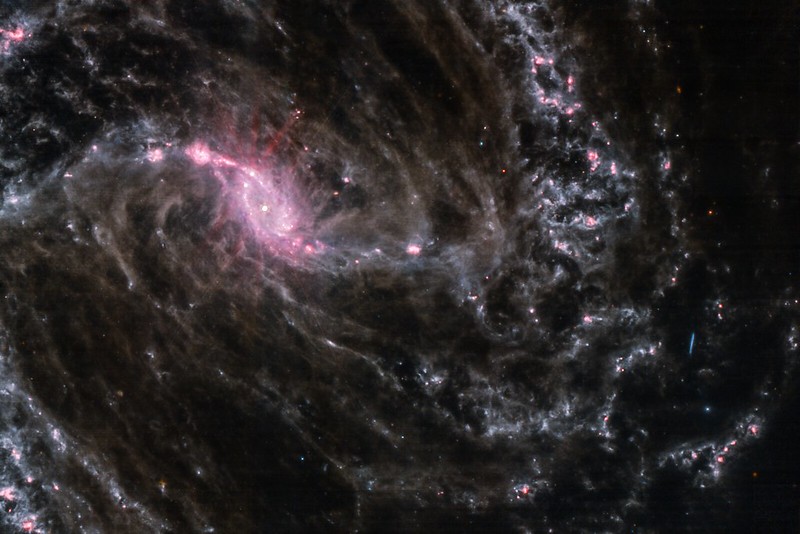 JWST MIRI, Barred spiral galaxy NGC1365
JWST MIRI, Barred spiral galaxy NGC1365
 Jupiter Widefield, NASA / ESA / CSA / Ricardo Hueso Alonso / Judy Schmidt
Jupiter Widefield, NASA / ESA / CSA / Ricardo Hueso Alonso / Judy Schmidt
A Sense of time
As is often the case I have a tendency to become less regular in my posting here. As I was writing up a description of a recent episode of the Discovery Podcast to share on a slack channel it occurred to me that this is exactly the sort of thing I should post here.
So, this was a fun podcast to listen to… about the perception of the passing of time in different animals. Basically, the perception of time is different based on sensory input, audio and visual, which varies. Flies, bats, and birds are discussed as examples of animals that have a higher frame rate of perception. In a sense, time seems slower for them or at least can be. For bats who can control their frame rate through clicks in the audio-echo based system, time can be slowed down as needed. So, when flying through an open space with little action they can conserve energy with fewer clicks but when hunting an insect they can speed it up from 1 click a second to 200 a second and slow their sense of time for accurate hunting. Kind of like increasing the resolution of what they hear/see as they need to.
First ever black hole image released
 This is a fantastic achievement.
This is a fantastic achievement.
It measures 40 billion km across - three million times the size of the Earth - and has been described by scientists as "a monster".The black hole is 500 million trillion km away and was photographed by a network of eight telescopes across the world.
The Beauty of Science
Came upon this article this morning: Swarm of mysterious radio bursts seen coming from deep space
Reading this article and thought I’d share for two reasons. First, it includes a very cool video that explains electromagnetism. It’s something I think everyone should have at least a basic understanding of given that it is one of the four fundamental forces of the Universe but also, it’s something we use everyday. It’s a very well done video.
Even if the actual topic of the article is not of great interest to some, it includes a very interesting discussion of the workings of science. In this case, it’s just a highlight of the process of data collection followed by an attempt to understand and interpret the data, then looking for more data and better quality data to further test the current ideas and so on. I think it’s great to see humans working together, collaborating in an attempt to understand one of the mysteries of nature. It’s the kind of example we can look to in times like these when we’re surrounded by political arguments and heightened social fractures of many kinds. It is possible for humans to play well together and, in the process, become more knowledgeable about the world around them.
This quote sums up the process and the attitude very well:
“There is a lot of fun in the not knowing,” he says. “You keep adding more information, but as in all sciences, whenever you solve one mystery, it always opens up three more.”
What is Earth Made of
One aspect of astronomy that I have grown to love and appreciate is the tie in to the other areas of science. For example, planetary geology which, in turn, ties into our study of our own Earth’s geology. Of course this also ties into chemistry. And biology. And on on and.
This morning as I browsed Apple News1 I came across this very nice introduction to the geology of our planet. A quick read that might lead you to a much deeper exploration.
So, for example, this little bit about the Earth’s crust:
Earth's crust is made up of several elements: oxygen, 46.6 percent by weight; silicon, 27.7 percent; aluminum, 8.1 percent; iron, 5 percent; calcium, 3.6 percent; sodium, 2.8 percent, potassium, 2.6 percent, and magnesium, 2.1 percent.
I always enjoy sharing with folks that particular tidbit about the crust being almost half oxygen. I think we generally think of oxygen as an important part of the air we breath and forget that it’s not just a gas. It’s fun to remind people that it also exists as a primary element in the oxide compounds of the ground we walk on!
Celebrating 40 years of Voyager
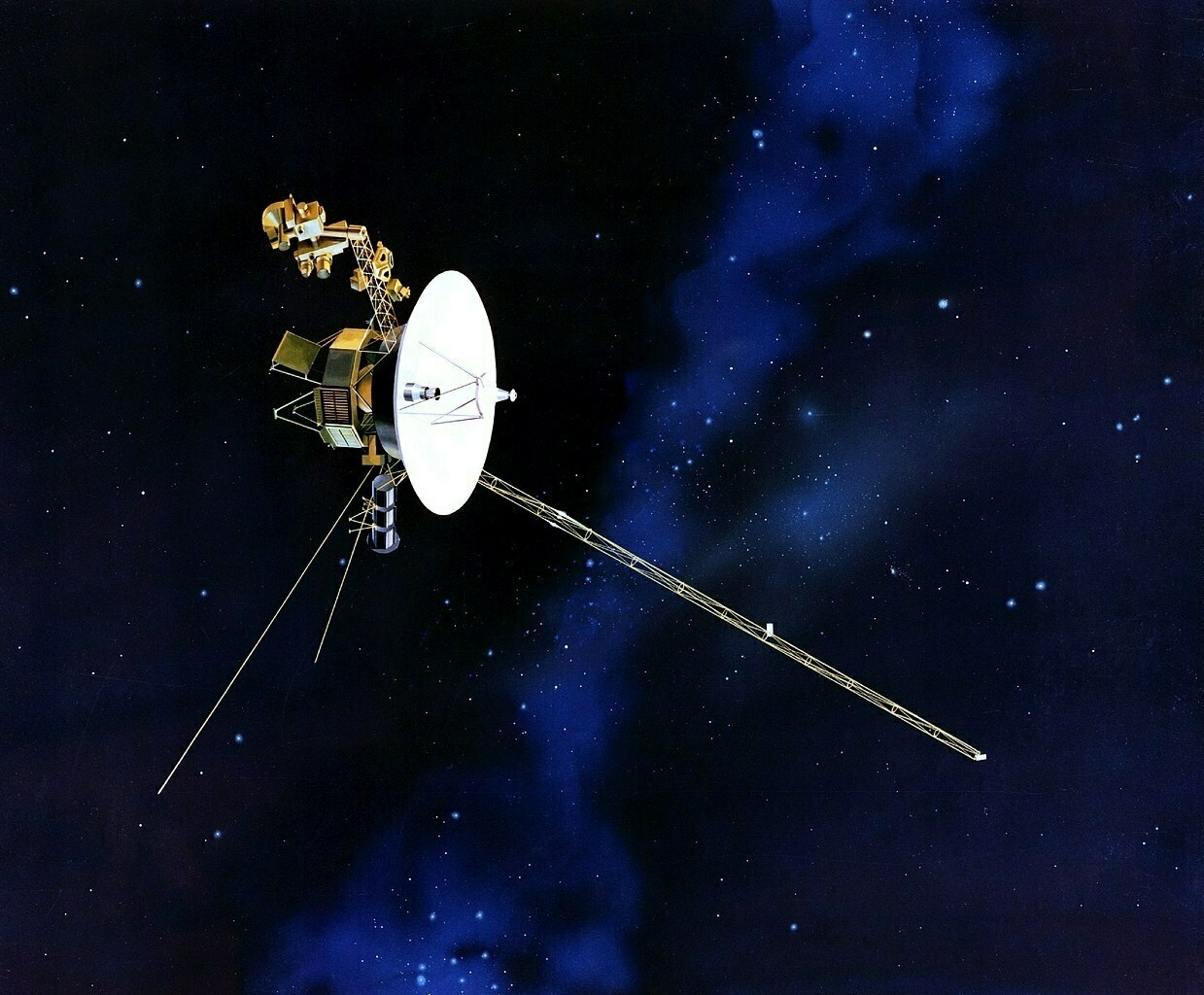
We are the only species that, due to it’s technological abilities, destroys habitat at unprecedented scale. How is it that a species which is supposedly so intelligent can cause such destruction to itself and it’s home? How is it that we can be precise in our engineering and yet so sloppy in our human interactions?

It helps to remember that we are primates. Which is to say, we’re just really smart, differently evolved Hominini, a member of the family of great apes. Perhaps from this context, it’s a bit easier to understand our persistent fallibility. As individuals and a collective, we live in fallibility though we are intelligent enough to deeply alter our environment. From fire to coal to oil to the atom; from simple tools to complex tools to earth moving machines to computers to robots exploring our solar system. We humans are constantly in a state of exploration and often destruction. Our evolutionary “success” seems to exist, though, on the finest of edges. With our ever increasing population (7.5 billion at this moment) dependent on a complex food system which is itself based on the availability of fossil fuels and a stable, semi-predictable climate.
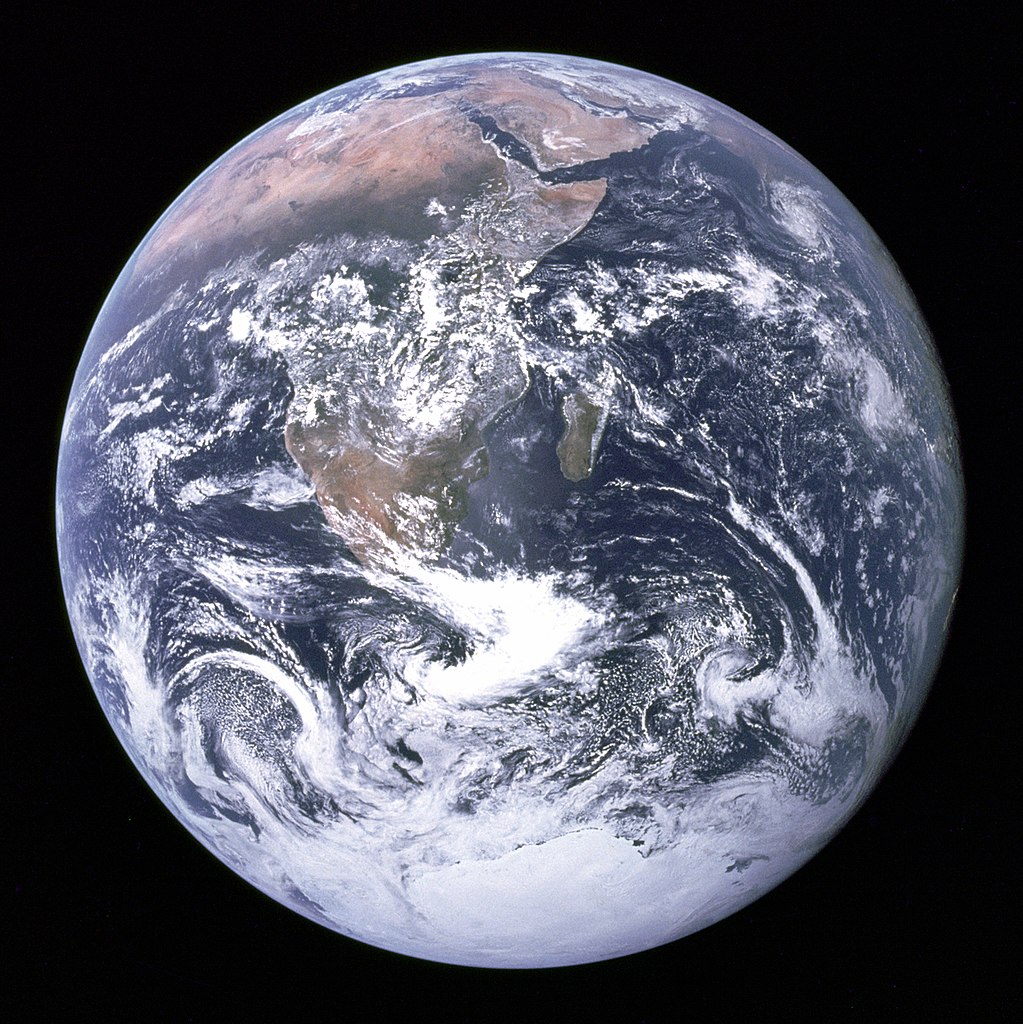
We are simultaneously capable of extended, deep reasoning as well as irrationality and superstition. In so many ways we, as individuals and as social systems, seem to reside in perpetual conflict. We often use the scientific method to wondrous and beneficial effect. Other times we use it to great disaster. Sometimes we push forward too fast, not knowing the results that may emerge. The full repercussions of our actions are often not known but even when they are predicted we fail to heed our own warnings.
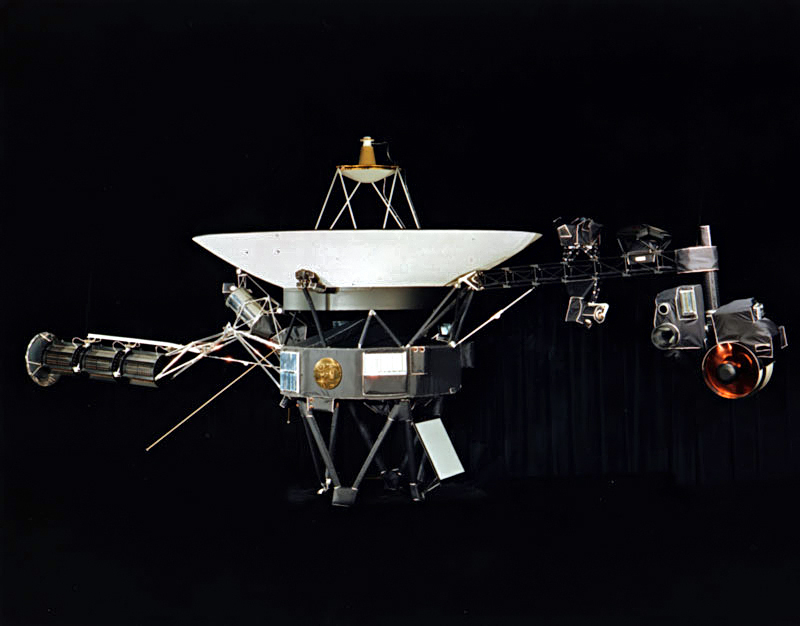
Our many societies, complex tapestries of history, culture, politics, ecology, science, art and economy, are often at odds with one another as well as with themselves. In so many ways the Voyager spacecraft are the perfect representatives of humanity. They embody our struggle with fallibility and our development of science as a method and a tool in response to that fallibility. We have developed and used these two spacecraft to explore our universe and to convey something of ourselves to it. At our very best we are explorers and communicators and sometimes our many voices are brought together in a shared expression of our common humanity.
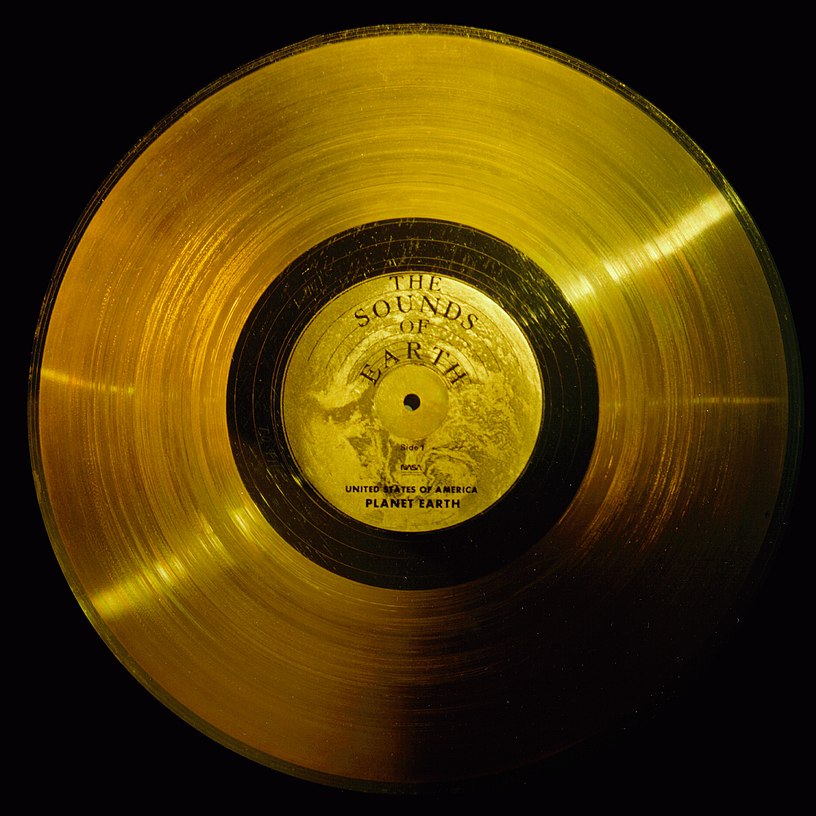
The Golden Records, our attempt to reach out into the unknown, to share something our tiny world, were created to carry our voices and our story as well as the sounds and images of our Earth. From bird song to whale song, Mozart to Blind Willie Johnson, to the sound of a human heart beating. In addition to a wide variety of audio he record included imagery ranging from illustrations of our solar system to DNA to daily life on our planet. Carl Sagan chaired the committee that spent a year selecting and then compiling the content. Included were the words of then U.S. president, Jimmy Carter:
"This is a present from a small, distant world, a token of our sounds, our science, our images, our music, our thoughts and our feelings. We are attempting to survive our time so we may live into yours."
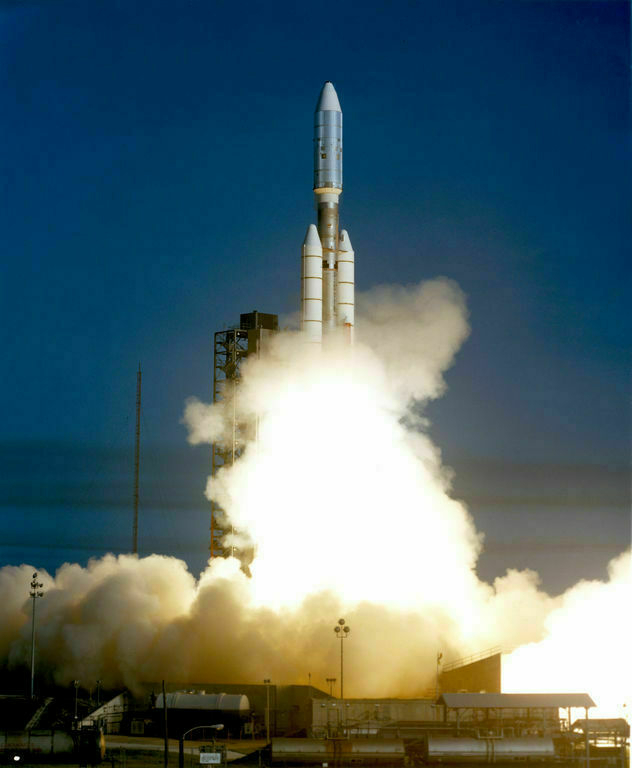
Of course, the spacecraft are far more than carriers for the Golden Records. In fact, the records were really intended to be the 2nd part of the mission, the purpose of the spacecraft after they no longer have the ability to transmit data back to us. The 1st part of their mission was, of course, the collection of data about our solar system a mission they are still performing even as they have ventured beyond the solar system.
With less computing power than a cell phone, they have, over the course of their mission, deepened our understanding our our solar system immensely. Beginning with Jupiter, and Saturn and then later Uranus and Neptune.
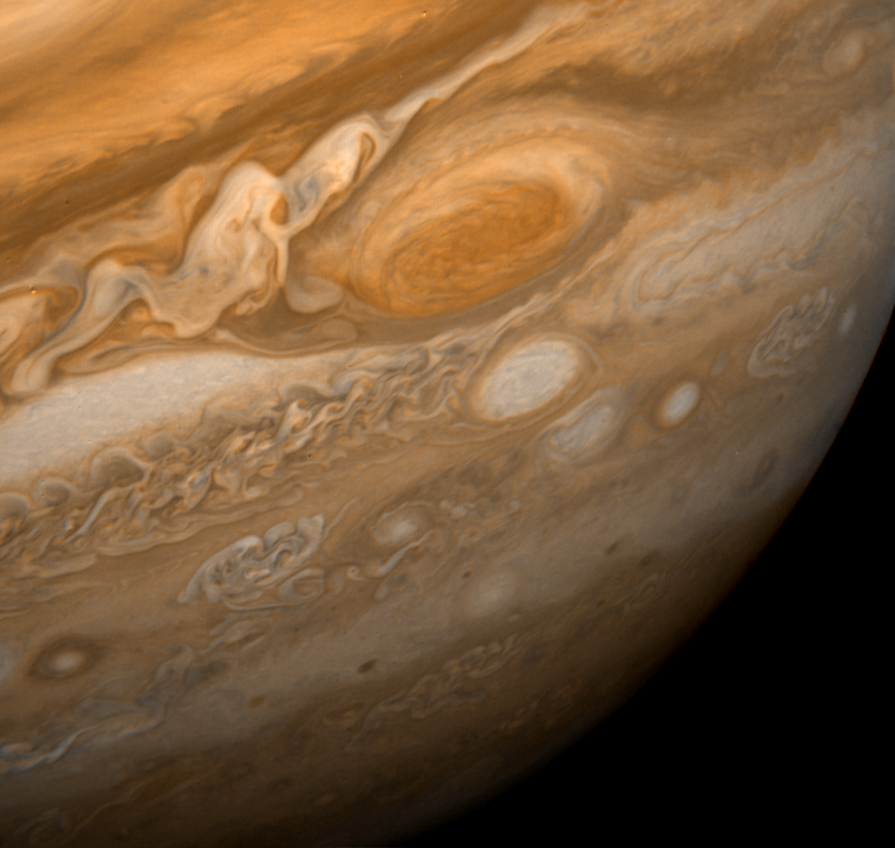
The first planetary encounter of the mission was Jupiter which began when Voyager 1 began taking photos in January 1979 with the closest approach on March 5 and final photos being taken of the planet and moons in April 1979. One of the highlights of this part of the mission was the discovery of volcanic activity on the moon of Io. It was the first time active volcanoes had been observed on another body within our solar system. Voyager’s mission at Jupiter was not the first encounter or the last. There have been 9 thus far.
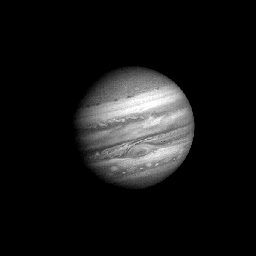 An animated view of Jupiter taken with photos taken every 10 hours.
An animated view of Jupiter taken with photos taken every 10 hours.
As Voyager was taking it’s photos of Jupiter it was also getting a gravity assist from the planet. Which is to say, it borrowed energy from the planet’s gravitation to change it’s trajectory and give it a boost to the next destination of its journey: Saturn. The Saturn encounter began November 1980 with closest approach on November 12, 1980 when it came within 77,000 miles (124,000 km). There have been a total of 4 spacecraft encounters with Saturn. Three of those were flybys and one, the Cassini-Huygens spacecraft, an extended mission which has been ongoing since 2004 and which will end in September 2017.
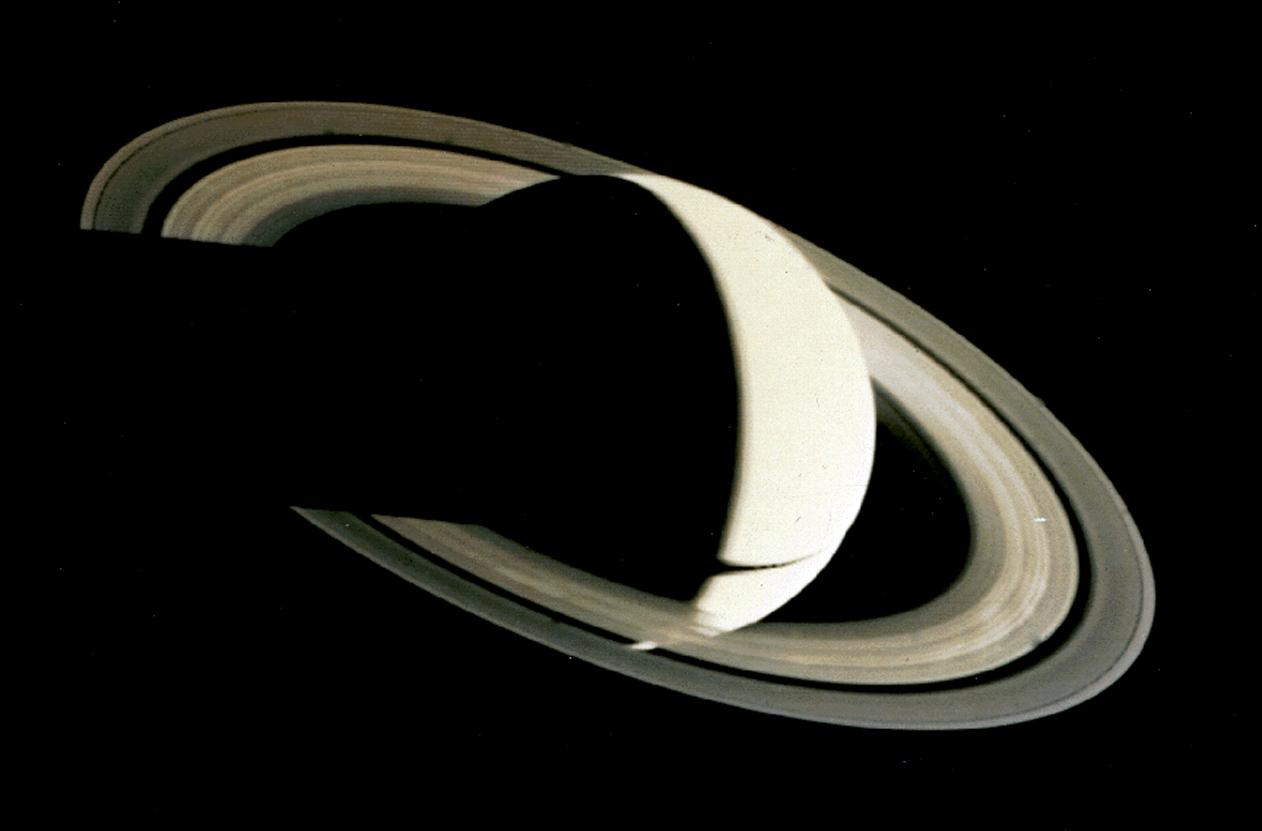
After Saturn, Voyager went on to Uranus and Neptune. Thanks to Carl Sagan, Voyager had one last photographic mission. The last photographs taken were a family portrait of our solar system. On February 14, 1990, at a distance of 6 billion kilometers from Earth, Voyager captured a mosaic of 60 photos including 6 planets: Jupiter, Earth, Venus, Saturn, Uranus and Neptune. It is from this series of images that the famous Pale Blue Dot photograph was taken. In the image the Earth is just a tiny blueish-white speck seen in a brownish band of light on the right side of the image.

"We succeeded in taking that picture, and, if you look at it, you see a dot. That's here. That's home. That's us. On it, everyone you ever heard of, every human being who ever lived, lived out their lives. The aggregate of all our joys and sufferings, thousands of confident religions, ideologies and economic doctrines, every hunter and forager, every hero and coward, every creator and destroyer of civilizations, every king and peasant, every young couple in love, every hopeful child, every mother and father, every inventor and explorer, every teacher of morals, every corrupt politician, every superstar, every supreme leader, every saint and sinner in the history of our species, lived there – on a mote of dust, suspended in a sunbeam.The Earth is a very small stage in a vast cosmic arena. Think of the rivers of blood spilled by all those generals and emperors so that in glory and in triumph they could become the momentary masters of a fraction of a dot. Think of the endless cruelties visited by the inhabitants of one corner of the dot on scarcely distinguishable inhabitants of some other corner of the dot. How frequent their misunderstandings, how eager they are to kill one another, how fervent their hatreds. Our posturings, our imagined self-importance, the delusion that we have some privileged position in the universe, are challenged by this point of pale light.
[…] To my mind, there is perhaps no better demonstration of the folly of human conceits than this distant image of our tiny world. To me, it underscores our responsibility to deal more kindly and compassionately with one another and to preserve and cherish that pale blue dot, the only home we’ve ever known." — Carl Sagan, speech at Cornell University, October 13, 1994
To celebrate the 40 year anniversary PBS has created a fantastic website and documentary, The Farthest: Voyager in Space. It is a truly wonderful documentary and I was moved to tears more than once while watching it. Stream it via their app or the above website. I’ll likely be watching it again. The website is beautifully done with a wealth of imagery, text and live display of the current Voyager mission time and distance from Earth.
Podcasts
I listen to a lot of podcasts and thought I might start mentioning my favorites here.
I’ll begin with two recently listened to. The TED Radio Hour is a favorite and one of the latest episodes is a perfect example of why I enjoy it so much. Hardwired. I’ve given it a listen but will need to give it a second. I always know a podcast is great when many of the episodes require at least a second listen.
Another favorite, Science Friday, has, as usual, aired another excellent episode. In particular I enjoyed the segments on Voyager which included a wonderful interview with planetary scientist Carolyn Porco as well as the segment on indoor microbiomes. Fascinating stuff. Check it out.
Voyager at 40
A great thread by @justinhendrix over on Twitter:
The solar eclipse Monday is set to overshadow another significant event for space nerds like me. Tomorrow, August 20th, is a special day.August 20th is the 40th anniversary of the 1977 launch of @NSFVoyager2, the first of two Voyager probes to explore the outer planets.
Its sister probe, Voyager 1, was launched 16 days later. These two probes represent one of humanity’s most extraordinary achievements.
Voyager 1 is nearly 13 billion miles from Earth; it takes a ray of light more than 19 hours to travel from here to its position.
Voyager 2 is nearly 11 billion miles and 16 light hours away. 5 years ago Voyager 1 entered interstellar space, on 25 August 2012.
Incredibly, both spacecraft are still sending scientific information about their surroundings through the Deep Space Network.
In the late 1960s that NASA determined a once-every–176 year alignment would allow a spacecraft to to visit all four outer planets.
Voyager delivered the first single frame photo of the Earth and the Moon together from space. twitter.com/justinhen…
The probes carried radioisotope thermoelectric generators powered by plutonium, and carry an array of scientific instruments. twitter.com/justinhen…
The computers aboard the Voyager probes each have 69.63 kilobytes of memory in total. That’s about enough to store one average .jpg.
The probes used assembly languages such as FORTRAN. Recently the Voyager program hired a new FORTRAN programmer. www.popularmechanics.com/space/a17…–1-voyager–2-retiring-engineer/
The probes visited all the giant outer planets, including Jupiter, Saturn, Uranus and Neptune. They made numerous important discoveries.
For instance, erupting volcanoes on Jupiter’s moon Io, the first evidence of volcanic activity elsewhere in the solar system.
The volcanos on Io were discovered by a JPL Voyager imaging scientist named Linda Moribito Kelly. www.planetary.org/blogs/gue…
Voyager discovered an ocean beneath the icy crust of Jupiter’s moon Europa, waves and fine structure in Saturn’s icy rings, Neptune’s…
Great Dark Spot and 1,600 kilometer-per-hour winds, geysers erupting from the polar cap Neptune’s moon Triton, and eventually…
The termination shock where supersonic solar wind slows down, forming the final frontier of the solar system. ibex.swri.edu/students/…
You can see many of the images that the Voyagers took during their trek through the outer planets here: www.jpl.nasa.gov/voyager/g…
Jupiter. twitter.com/justinhen…
Saturn. twitter.com/justinhen…
Uranus. twitter.com/justinhen…
Neptune. twitter.com/justinhen…
And the famous Pale Blue Dot photo, which inspired Carl Sagan’s speech, which we should all listen to & consider www.youtube.com/watch
The Voyagers also famously carry a Golden Record, which carries the sounds of earth into space- Sagan’s idea. www.npr.org/2017/08/1…
Blind Willie Johnson’s ‘Dark Was the Night, Cold Was the Ground’ is one of the songs now in interstellar space www.youtube.com/watch
The Voyagers represent the best of humanity. The best scientific thinking, engineering, ambition, curiosity, passion, arts and culture.
We’d do well at this moment, 40 years hence, to look at the legacy of these probes, and consider what we can learn from their journey.
It’s more than the sum of their scientific discoveries. They explore the universe, but they also tell us something about ourselves.
Our best selves. Voyager is the best of humanity. We need to remember the aspiration to be our best selves, to advance the species.
So enjoy the eclipse, but spare a moment tomorrow at 10:29 AM Eastern to remember the launch of @NSFVoyager2, a great human achievement.
Here is an excellent hour on the history of Voyager from the BBC. h/t @acinonnap www.bbc.co.uk/programme…
